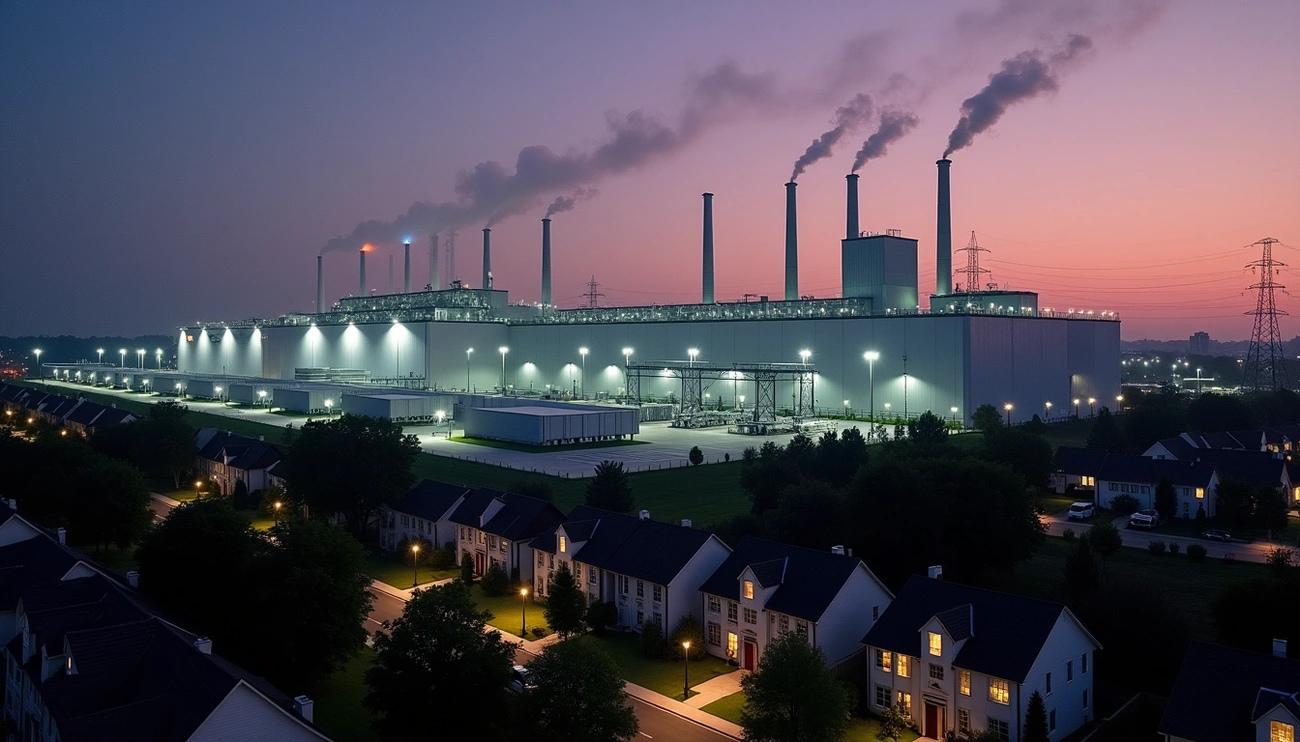What are your thoughts on data centers?
Data centers might pose risks to their host communities. These digital hubs are growing fast, and this raises real concerns about their effect on the environment, health, and resources. Data centers used 4% of all U.S. electricity in 2023. This number could jump to 6-12% by 2030 . A single large data center needs about 5 million gallons of water each day – the same amount that a town of 50,000 people uses .
The problems go beyond just using too many resources. Almost a third of California’s working and planned data centers sit in areas already dealing with serious diesel pollution . This shows why data centers can be bad news for many local residents. Scientists at UC Riverside and Caltech predict these facilities could trigger 600,000 asthma attacks by 2030. The health costs could reach $20 billion .
Data centers do bring some good news. They create jobs and boost local tax income. Take Virginia as an example. The state gained over 26,000 jobs in operations and construction during 2023 . Local governments collected $1 billion in taxes from these facilities in 2022 . The benefits look good, but people still ask if living near a data center is safe. Communities now face proposals that could add up to 80 million square feet of new facilities nationwide . They must weigh both sides carefully.
Understanding the core safety risks of data centers
Data centers create several major safety risks that go beyond just using up resources. Their biggest threat lies in how they affect electrical grid stability. Power grids can experience cascading outages that affect whole regions at the time these facilities suddenly disconnect [1]. Grid operators have documented more than 30 “near-miss” incidents over the last several years since 2020 [1].
The situation becomes more concerning with data centers creating “bad harmonics” – these erratic voltage spikes damage household appliances and raise fire risks. Research shows that 75% of highly distorted power readings show up within 50 miles of major data center operations [2].
These facilities’ health effects are also worrying. People who keep taking in fine particulates from diesel backup generators often develop respiratory problems [3]. On top of that, the chemically treated cooling water becomes unsafe for drinking or farming [4].
Research indicates that living close to data centers doesn’t pose electromagnetic field risks [5]. However, water availability has become a critical issue. Meta’s data center construction in Georgia led to nearby residents’ wells running dry [6].
The cooling systems and backup generators create noise that disturbs local residents despite soundproofing efforts [5]. These facilities put pressure on local utilities and can drive up residential costs, while companies often get better utility rates [4].
How data centers affect communities differently
Data centers’ community effects largely depend on where they’re built. Communities in Western states like California and Texas that already face serious environmental challenges often become home to these facilities [7]. The situation looks different on the East Coast. Virginia’s data centers tend to pop up in areas with fewer environmental problems. All the same, clusters with high or very high environmental justice burdens house more than 40% of data centers across the country [7].
Communities where these centers appear often struggle with poverty and lower education levels. Research shows a strong relationship (r = 0.867) between social vulnerability and data center locations [7]. This pattern makes us ask hard questions about how companies choose their sites.
The promised economic rewards don’t quite add up. Virginia’s data centers brought in $1 billion in tax money [8]. Yet each facility creates nowhere near 100 direct jobs [8]. Local residents might see their electricity bills jump by 19% by 2028 as these centers’ power needs grow [9].
Different locations use vastly different amounts of resources. New data centers planned for Virginia would just need 40 gigawatts of extra power – almost three times what the state can currently produce [10]. Local communities trying to meet their climate goals might stay stuck with fossil fuels longer than planned [11].
Living near these centers makes everything worse. One neighbor summed it up perfectly when they asked about the cooling systems: “How am I going to relax with something buzzing at me 24/7?” [10]
What local communities can do to stay informed
Local communities now have powerful tools to stand up for their rights when data centers come knocking. Recent tracking shows grassroots groups fighting data centers have sprung up in 28 U.S. states [12]. These groups serve as the first defense line against questionable developments.
Community action that works usually starts with letter-writing campaigns and residents speaking up at government meetings [12]. These grassroots efforts pack a real punch. A developer in Virginia pulled its rezoning application after facing strong public feedback [13].
Residents need reliable information to make their case. Tools like CalEnviroScreen offer interactive maps that show pollution levels in different areas [14]. These maps help identify neighborhoods that already bear too much environmental burden. Some places, like Washington state, make data centers complete health impact studies before they can build [15].
What should communities just need:
- Regular reports on energy and water use, similar to California’s proposed laws (AB 93 and AB 222) [16]
- New industrial zoning rules that look at the full picture of impacts [16]
- Health impact studies before construction that everyone can see [16]
Communities nationwide have won fights against old zoning rules. Lancaster, Pennsylvania’s residents asked whether data centers could really count as “wholesale trade and storage.” They ended up getting a public hearing to look at this classification again [17].
Conclusion
Data centers are without doubt a double-edged sword for local communities. They create jobs and generate tax revenue, but safety risks need our attention. Local residents face legitimate concerns about unstable electrical grids, diesel generators causing air pollution, water contamination, and resource depletion.
Local communities must carefully evaluate these trade-offs. Data centers’ disproportionate concentration in vulnerable areas raises serious environmental justice questions. These digital fortresses strain local utilities heavily. Companies often get preferential rates that could push costs onto residential users.
Communities should organize and promote their interests when facing data center proposals. People have successfully used letter-writing campaigns and public comments at government meetings to voice their concerns. They have also asked for detailed health impact assessments. On top of that, they can push for mandatory resource usage reports and updated zoning rules that show the full picture of cumulative effects.
We need balanced solutions that recognize both economic benefits and environmental costs of these facilities. Future development requires transparency, accountability, and community participation at every stage. Communities can ensure these digital infrastructure hubs serve their long-term wellbeing through informed participation.
What do you think?
References
[1] – https://www.reuters.com/technology/big-techs-data-center-boom-poses-new-risk-us-grid-operators-2025-03-19/
[2] – https://www.datacenterdynamics.com/en/news/ai-data-centers-causing-distortions-in-us-power-grid-bloomberg/
[3] – https://www.staxengineering.com/stax-hub/the-environmental-impact-of-data-centers/
[4] – https://utulsa.edu/news/data-centers-draining-resources-in-water-stressed-communities/
[5] – https://www.eziblank.com/is-it-dangerous-to-live-near-a-data-center/
[6] – https://www.nytimes.com/2025/07/14/technology/meta-data-center-water.html
[7] – https://www.linkedin.com/pulse/environmental-justice-us-data-centers-key-insights-equitable-kmetz-326vf
[8] – https://apnews.com/article/data-centers-artificial-intelligence-technology-amazon-google-56b84cbb94942039754282afb076a87b
[9] – https://www.ncelenviro.org/resources/data-centers-issue-brief/
[10] – https://www.npr.org/2025/07/17/nx-s1-5469933/virginia-data-centers-residents-saying-no
[11] – https://fordschool.umich.edu/news/2025/growth-data-centers-requires-new-policies-mitigate-local-community-impacts
[12] – https://www.datacenterwatch.org/report
[13] – https://www.datacenterfrontier.com/site-selection/article/55307719/when-communities-push-back-navigating-data-center-opposition
[14] – https://oehha.ca.gov/calenviroscreen/report/calenviroscreen-40
[15] – https://ecology.wa.gov/air-climate/air-quality/data-centers
[16] – https://techpolicy.press/data-center-boom-risks-health-of-already-vulnerable-communities
[17] – https://www.govtech.com/products/lancaster-pa-hearing-to-revisit-data-center-zoning-decision

